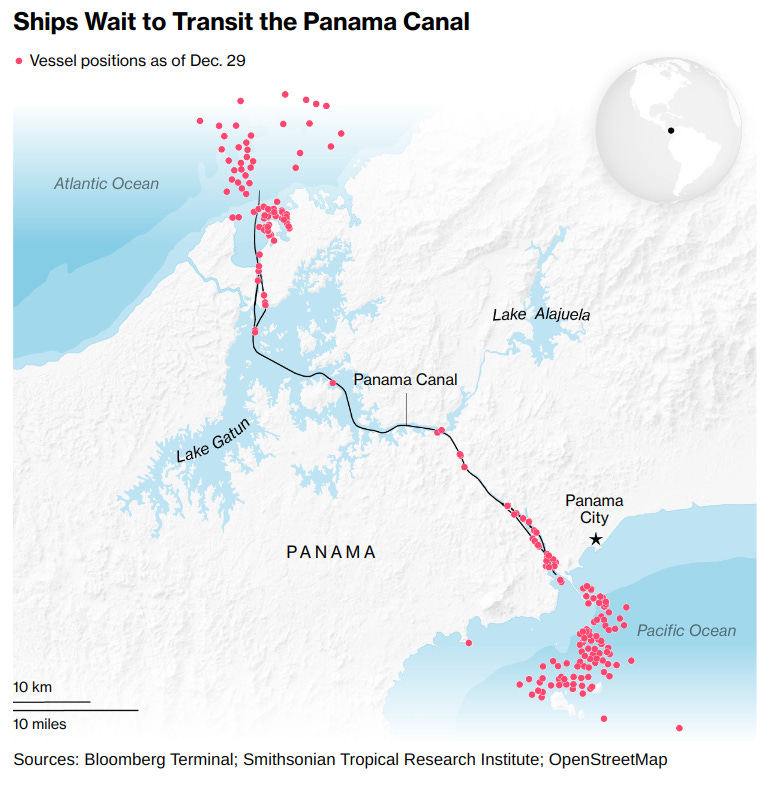Fixing the Panama Canal
The Global Warming threat to international shipping

One of the discussions in the global warming arena — relatively hidden from most people by the ever-careful press — is the tension between preserving our modern, high-tech, energy-intensive, globally dependent life on the one hand, and the need to preserve a human-friendly environment on the other.
Global Life in the Balance
The question — Can we preserve our modern high-energy-use lives and still have a livable world? — is rarely asked. Yet that’s perhaps the most important question of them all.
Let’s say, for example, that we have (I’m pretending) twenty years to deal with climate change effectively, after which we can’t. How should we spend those twenty years? What solutions should we pursue? If we choose to pursue unviable ones, we’ve wasted our time.
Or, as some genius almost wrote, It makes no difference how fast you climb the ladder, if it’s the wrong ladder.

The information below, from Bloomberg News, should be part of that discussion. Bottom line: Global warming is destroying the Panama Canal.
With water levels languishing at six feet (1.8 meters) below normal, the [Panama Canal] authority capped the number of vessels that can cross. The limits imposed late last year were the strictest since 1989, when the conduit was shut as the US invaded Panama to extract its de facto ruler, Manuel Noriega. Some shippers are paying millions of dollars to jump the growing queue, while others are taking longer, costlier routes around Africa or South America.
The constraints have since eased slightly due to a rainier-than-expected November, but at 24 ships a day, the maximum is still well below the pre-drought daily capacity of about 38. As the dry season takes hold, the bottleneck is poised to worsen again.
According to the US International Trade Commission, the Canal “has 46% of the total market share of containers moving from Northeast Asia to the East Coast of the United States.”
A reduction to 24 ships per day from the normal 38 doesn’t sound like a lot, but that’s a 36% loss in annual Canal traffic. Imagine the East Coast without 17% of its Asian-sourced fuel and goods, or having to bear the cost of rerouting that traffic through thousands more miles at sea.
Modern, high-tech, energy-intensive global life is under threat. What’s the price of saving it? What’s the price if we try to save it and fail?
Fixing the Panama Canal
Plans to “fix” the Canal sound like plans to “fix” the climate: Bill Gates-style high tech fantasies.
“In the long term, the primary solution to chronic water shortages will be to dam up the Indio River and then drill a tunnel through a mountain to pipe fresh water 8 kilometers (5 miles) into Lake Gatún, the canal’s main reservoir.”
That’s a $2 billion project if it comes in on budget. But is it a long-term fix? Bloomberg admits that Panama “will need to dam even more rivers to guarantee water through the end of the century.” Sounds like Band-Aids to me. Lots of them. And residents of the to-be-flooded land are vigorously opposed, so it will be a political fight to move them.
“Another potential fix is decidedly more experimental … cloud seeding, the process of implanting large salt particles into clouds to boost the condensation that creates rain.”
The article is not optimistic that this will work. Another Gatesian dream: Pretty. Impossible. Or to say that differently, pretty impossible.
The Price of Global Life
As Bloomberg notes, “The crisis has set back available shipping routes by more than a century. When it began operating in 1914, the canal provided an alternative to the Suez Canal, the Cape of Good Hope and the Strait of Magellan to send goods between the Northern and Southern Hemispheres.”
With the Canal at reduced capacity, the cost of global shipping is going up — picture those Asian containers moving east, not west, to arrive in New York harbor — and the other alternatives are themselves being strained (see link in quote above). Now add in the threats in the Suez thanks to Israel’s determined and inflammatory war against Gaza, and there’s a problem that lacks a solution.
So again, which will be first to fail? A livable climate? Or modern high-energy life?
Place your own bets — your betters have already placed theirs.



I place my bets on revenue stream maximization for our billionaire overlords. Without access to the models churning away in NYC and Silicon Valley I am leaning towards the massive profit potential of canal reconstruction along with the prospect of lower shipping costs. However, a time, value, money model might just burp out building seawalls for the Northeast American coast to keep those consumers in place and consuming away.
I will bet that keeping the status quo and maintaining the supply of cheap Vietnamese galoshes for Northeast American residents dictates directing the geoengineering towards the Panama Canal reconstruction. The powers that be will not be wading with us.
Naked Capitalism brought me here., and I'll be back. Thanks for this revealing post. Happy New Year.